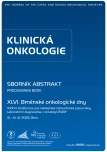Retrospective study of patients with tubo-ovarian cancers (n = 510) and an analysis of main factors influencing PFS and OS – the experience of a comprehensive oncology center during 2010–2019
Authors:
S. Vokurka 1; M. Ambrožová 2
; O. Ngo 2; V. Vaněček 3; O. Fiala 1; M. Votavová 1; O. Hes 4; Jiří Presl 5
; J. Ferda 6
; J. Fínek 1
Authors‘ workplace:
Onkologická a radioterapeutická klinika LF v Plzni UK a FN Plzeň
1; Institut bio statistiky a analýz, LF MU Brno
2; Ústav farmakologie a toxikologie, LF v Plzni UK
3; Šiklův ústav patologie, LF v Plzni UK a FN Plzeň
4; Gynekologicko-porodnická klinika LF v Plzni UK a FN Plzeň
5; Klinika zobrazovacích metod LF v Plzni UK a FN Plzeň
6
Published in:
Klin Onkol 2022; 35(Supplementum 1): 148-151
Category:
Article
Overview
Background: C56 malignancies are significant diseases. In the Czech Republic, the incidence of 956 and mortality of 637 cases were reported in 2018 (data from the registry of the Institute of Health Information and Statistics of the Czech Republic). Carciomas are a dominant group. The backbone of first-line treatment is a sufficiently radical surgery and chemotherapy with carboplatin (paclitaxel/ carboplatin) in the vast majority of cases. Analyses of treatment outcomes in CZ centers are presented infrequently. Patients and methods: Patients with a new diagnosis and morphologically verified tubo-ovarian cancer in the period 2010–2019 and active care within comprehensive oncology centre FN Plzen. Basic factors with possible influence on time from diagnosis to progression (progression-free survival – PFS) or death (overall survival – OS) were monitored: the state of complete remission (CR) in the first line of treatment (yes vs. no), grade (low = 1–2 vs. high = 3–4), stage (1 vs. 2 vs. 3 vs. 4), type (serous vs. non-serous, unspecified), age (< 65 years vs. ≥ 65 years), year of diagnosis (2010–2012 vs. 2017–2019). The Kaplan-Meier estimate of survival function, log-rank test and median survival were used for PFS and OS analysis. Results: Registered n = 510 patients, of which n = 498 valid for PFS and n = 507 for OS. A statistically significant difference in survival curves (P ≤ 0.001) was demonstrated for PFS according to the stage: I (median survival not reached), II (49 months), III (16 months), and IV (14 months); by grading: low (36 months) vs. high (19 months); according to CR achievement: yes (33 months) vs. no (11 months); by age: < 65 years (23 months) vs. ≥ 65 years (15 months). Statistically significant differences in OS (P ≤ 0.019) were also recorded according to the stage: I (median not reached), II (median not reached), III (36 months), IV (27 months); by grading: low (87 months) vs. high (46 months); according to CR achievement: yes (91 months) vs. no (18 months); by age: < 65 years (66 months) vs. ≥ 65 years (32 months). A statistically significant difference between PFS and OS according to the type of malignancy and the year of diagnosis was not proven. Conclusion: The presented set can be considered representative and unselected. We confirm the generally expected results, which are the result of a comprehensive multidisciplinary cooperation with the crucial position of surgical resections (note: in unresectable cases, the state of CR during chemotherapy with potentially bevacizumab was only 9%). Comparison of the results by treatment period (2010–2012 vs. 2017–2019) did not show differences and further monitoring or multicentre cooperation would be needed to evaluate the effect of bevacizumab, or more recently PARPi maintenance treatment, or the concentration of surgery in complex cancer centers. The real world data file can be a source for further analysis and research.
Keywords:
ovarian cancer – oncology – gynecology
Sources
1. Krejčí D, Pehalová L, Talábová A et al. Novotvary 2018. Ústav zdravotnických informací a statistiky ČR. [online]. Dostupné z: www.uzis.cz
2. Bednaříková M, Cibula D, Fischerová D, et al. Zhoubný novotvar ovarií a tuby (C56–57). In: Igor Kiss (ed.). Modrá kniha České onkologické společnosti. 28. vyd. Brno: Masarykův onkologický ústav 2022.
3. Kulhavý M, Kmoníčková E, Petera J et al. Terapie pokročilých stádií karcinomu ovaria, desetileté zkušenosti ústavu. Klin Onkol 1997; 10(4): 116–120.
4. Woopen H, Richter R, Ismaeel F et al. The influence of polypharmacy on grade III/ IV toxicity, prior discontinuation of chemotherapy and overall survival in ovarian cancer. Gynecol Oncol 2016; 140(3): 554–558. doi: 10.1016/ j.ygyno.2016.01.012.
5. Woopen H, Inci G, Richter R et al. Elderly ovarian cancer patients: an individual participant data meta-analysis of the North-Eastern German Society of Gynecological Oncology (NOGGO). Eur J Cancer 2016; 60: 101–106. doi: 10.1016/ j.ejca.2016.03.008.
6. Joueidi Y, Dion L, Bendifallah S et al. Management and survival of elderly and very elderly patients with ovarian cancer: an age-stratified study of 1123 women from the FRANCOGYN group. J Clin Med 2020; 9(5): 1451. doi: 10.3390/ jcm9051451.
Labels
Paediatric clinical oncology Surgery Clinical oncologyArticle was published in
Clinical Oncology

2022 Issue Supplementum 1
- Metamizole vs. Tramadol in Postoperative Analgesia
- Metamizole at a Glance and in Practice – Effective Non-Opioid Analgesic for All Ages
- Possibilities of Using Metamizole in the Treatment of Acute Primary Headaches
- Current Insights into the Antispasmodic and Analgesic Effects of Metamizole on the Gastrointestinal Tract
- Spasmolytic Effect of Metamizole
Most read in this issue
- VIII. Radioterapeutické metody a radiofarmaka
- XXVIII. Neuroendokrinní a endokrinní nádory
- IV. Follow-up, sledování onkologických pacientů
- XXII. Nádory slinivky, jater a žlučových cest
